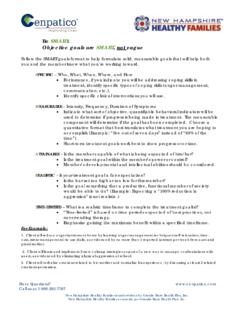Transcription of SMART Goals & Mental Health
1 SMART Goals & Mental Health Overview Goal setting can be used as a Mental Health tool. Particularly for people who experience both developmental disabilities and Mental Health concerns, setting Goals for themselves can be a valuable strategy. When setting and achieving Goals , individuals are exercising autonomy, which is a vital feature of Mental Health . There are certain features which make a quality goal. These features are referred to as SMART Goals , which stands for specific, measurable, attainable, relevant, and time-bound Goals .
2 Goal Setting and Mental Health Although goal setting is often associated with the beginning of a new year, setting Goals can be a useful tool any time of the year. Not only is goal setting useful for personal progress, but it can also be a therapeutic intervention to improve Mental Goal setting can be particularly useful as a Mental Health tool for people with intellectual and/or developmental disabilities (IDD). People with IDD experience Mental Health concerns at a higher rate than people without In addition, traditional therapeutic interventions are often not practiced with enough flexibility to meet the needs of individuals with IDD ( , when feelings are difficult to put into words, or when the individual does not have verbal ability).
3 Goal setting is a Mental Health strategy that can be used without necessarily needing the guidance of a Mental Health The act of setting Goals is intertwined with the principles of self-determination, which are essential to Mental , 2 Specifically, setting Goals allows the individual to choose what tasks are important to them and create a plan to complete them, of their own free This act oself-determination is especially important for people with IDD because their independence is often limited in many ways. Opportunities for autonomous decision making are also important for improving problem behaviors associated with Mental illness.
4 Decisions as simple as choosing a snack have shown improvements in behaviors such as aggression in previous f Principles of SMART Goals When setting Goals , it can be helpful to begin by defining the individual s intentions for the What do they hope to accomplish by setting this goal? How will it benefit them? Writing down certain details about the goal may also help them connect with, remember, and follow-through with what they set out to SMART Goals are defined differently across various subject areas and historical For the purpose of this fact sheet, the principles of SMART Goals are as follows: Specific, Measurable, Attainable, Relevant, and , 4 S Specific First, the person should ask themselves exactly what it is they wish to accomplish and write it down as instructions for The more specific they can be, the better.
5 For example, rather than stating, I want to read more books, , they might say, I want to read two books every month. Other specifics about the goal might be who else should be involved, any preparation needed, perhaps a specific location, and why this is the In the example, it may be helpful to read with someone else. They may need to arrange for regular visits to the library or purchase software to borrow books virtually. The goal setter should consider their overall objective as they make these decisions. For example, if they want to decrease their time spent looking at devices with screens, their preparation for this goal would look very different than if their objective is to practice and improve reading ability.
6 M Measurable A clear and achievable goal is something that can be monitored for progress - through smaller tasks leading to completion, due dates, collecting data, etc. Measurements may vary wildly, and the person may need some creativity, depending on what the goal In the example, measurement is fairly simple two books should be read during each month. It is important to clarify progress measurement when setting the goal, as well as data collection throughout the process of goal achievement. How often will the individual check-in on their progress?
7 What exactly will they be monitoring? A Attainable Goal setting will not be an effective Mental Health tool if the goal is too challenging to achieve. Consider whether the time and resources necessary to complete the goal are available, and if it is feasible for the individual. If needed, break the goal down into smaller Goals or steps and start with one of Continuing with our book reading example, the individual may decide to start by reading 1 book per month and increase to 2 books per month after a few months, depending on their progress.
8 R Relevant Is the goal appropriate for the individual and their needs? It should benefit them in some way and cater to their personal preferences as well. If the person feels no connection to the goal s objectives, it is unlikely they will commit to follow-through with If the person setting the goal in our example is already reading 2 books per month, this goal would not be relevant to them. In that case, a better goal would be to increase somehow read 3 books a month, or perhaps to increase the reading level of the books. T Time-bound In order to be effective, a goal should have clear time limits that are There should be enough time to complete the goal, but still be a motivating challenge.
9 In our example, the goal to read 2 books every month is a good way to specify what will be accomplished (hopefully), but there needs to be a set end to the goal. The person might decide to read 2 books every month for 3 months, then evaluate their progress and set another goal. Setting SMART Goals is a way to make personalized improvements or achievements, and achieving these Goals is beneficial for Mental Health . The act of deciding what to work on for oneself and following through with them is an act of self-determination. Accomplishing something meaningful for oneself boosts self-confidence and Mental wellness.
10 Goals can be set as a part of a larger program or therapeutic plan, or simply on an individual basis the benefit can be the same. Additional Resources Video about setting SMART Goals from Khan Academy. SMART Goals Worksheet from Contributors Malinda Dokos, MS Faith Thomas, PhD Tatiana Perilla, MSW References 1. Clark, E., Olympia, D. E., Jensen, J., Heatherfield, L. T., & Jenson, W. R. (2004). Striving for autonomy in a contingency-governed world: Another challenge for individuals with developmental disabilities. Psychology in the Schools, 4(1).








